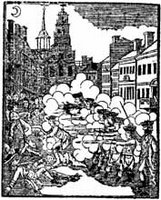“Alarming Apprehensions” and the Mysterious Dr. Gilson
Boston selectman Timothy Newell must have been nervous when he started his last diary entry for February 1776 with “Thursday 25th.” As the person who transcribed this document for the Massachusetts Historical Society’s Collections series noted, the 25th was a Sunday. Context indicates that Newell probably wrote this entry on Thursday the 29th:
From the accounts of Dr. Gilson, and some others Deserters from the Continental army, great preparations were making to attack the Town,—caused very alarming apprehensions and distress of the Inhabitants.Newell had stayed in Boston not because he supported the Crown but because he felt a responsibility to guard the town from the damages of war. Now the Continental artillery was preparing to bombard Boston, as Gen. George Washington had described days before.
After reading this diary entry, I wondered who “Dr. Gilson” was. Newell called him a deserter, and deserters are always interesting. But it took a lot of digging to find even a little about the man. His name doesn’t appear on the list of colonial Boston’s physicians published by the Colonial Society of Massachusetts, for example. Fortunately, we now have Google.
On 19 Apr 1764, while Boston was under threat from a smallpox epidemic, the selectmen summoned every physician in the area to discuss how they were treating patients and inoculating people safely. “Dr. Samuel Gilston” was one of the doctors who did not attend that meeting.
Jacob Rader Marcus’s compilation of documents from the eighteenth century on the topic of American Jewry offers a very good clue about the man. (Only Google Books allowed me to find this.) In 1770 Aaron Isaacs of East Hampton, Long Island, wrote to a Newport businessman that “Docter Gilston” owed him money. He added, “He is a docter and neavel offesur at Nantucket.” Gilson might therefore have been working as a ship’s doctor for the Royal Navy.
Isaacs (1724-1798) was born in Hamburg, moved to Long Island, and eventually converted from Judaism to Presbyterianism. His daughter Sarah married a Cape Cod man named William Payne, and their son John Howard Payne wrote “Home, Sweet Home.” But I digress.
Then the war broke out. If Dr. Gilston had ties to the navy and to Nantucket, which was known for its Loyalism, the Whig authorities in Massachusetts might well have seen him as an enemy. So they locked him up. William Pynchon of Salem wrote in his diary on 29 Feb 1776, the same day Newell heard the upsetting rumors:
News came that Dr. Gilson and others broke out of Plymouth jail and got into Boston; and by advices from Dr. Eliot and Mr. Payson that the Regulars at B[oston]. are preparing to quit the town; and from others that the Provincials are busy in preparing to bombard the town, and to erect works for that end on the hill at Dorchester, near the Neck.Dr. Eliot was probably the Rev. Dr. Andrew Eliot, one of the Congregationalist ministers who had stayed in occupied Boston. Mr. Payson was probably the Rev. Phillips Payson of Chelsea.
Dr. Gilston was not on the list of civilians evacuated from Boston in 1776, nor was he listed as an absentee by the state in 1778. Instead of leaving, he appears to have returned to Nantucket and become part of that community’s struggle to stay out of the fighting that followed.
I found two more glimpses of the doctor during the war. In 1779, a Nantucket man named Thomas Jenkins complained to the Massachusetts Council about five islanders trying to aid the British military and summoning their “predatory fleet” to the island. Jenkins wrote, “Dr. Samuel Gilston will prove this confession.” Gilston signed this complaint as a witness.
In addition, Dr. James Thacher’s Military Journal recorded some gossip about the British general Richard Prescott, who had been captured and exchanged:
After the general was exchanged, and he resumed his command on the island, the inhabitants of Nantucket deputed Dr. Gilston to negotiate some concerns with General Prescott, in behalf of the town. Prescott treated the Doctor very cavalierly, and gave as the cause, that the Doctor looked so like that d—d landlord, who horsewhipped him in Connecticut, that he could not treat him with civility.The islanders might have chosen Dr. Gilston to be their liaison with Gen. Prescott because he had old ties with the British military.
I’ve also found indications that a boy named “Gilson” entered Boston’s South Latin School in July 1773, as noted by assistant teacher James Lovell, and that Roland Gilson was later a physician on Nantucket. Was this Dr. Samuel Gilston’s son, sent to Boston for a classical education and then taking over his father’s practice?
(Thumbnail map of Nantucket above, actually drawn in the 1940s, courtesy of Rev. A. K. M. Adam’s blog.)
ADDENDUM: Thanks to reader Tom Macy, I’ve found much more about this doctor. It turns out he preferred to spell his last name “Gelston.”




